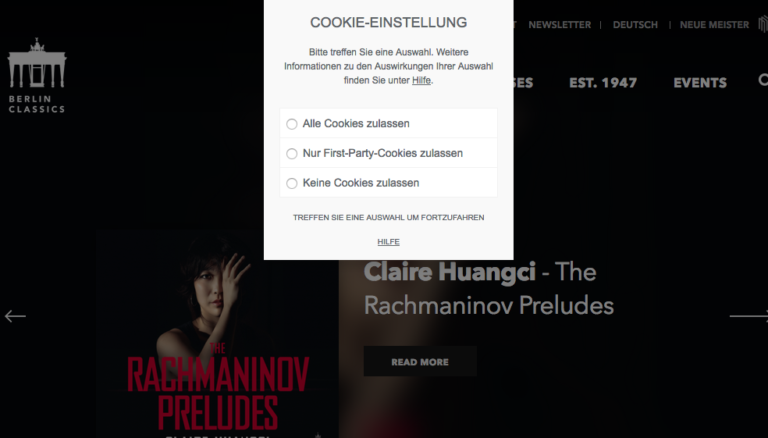
My office this morning is a table in the back of Bagel Beanery, the purveyor of the largest, tastiest bagels in Grand Rapids (for whatever that’s worth).
So, as I sip my Breakfast Blend coffee, and munch on my Dill Havarti bagel (toasted with plain cream cheese), I listen to German conductor Franz Konwitschny (1901-1962) do his thing with the Gewandhausorchester Leipzig. The label that released this unassuming box set is Berlin Classics – a label, by the way, that greets visitors with this cryptic pop-up notice:

In short, what the hell does that mean? I know it has something to do with cookies. What I don’t know is what the three radio buttons mean, which is an oversight on the part of Berlin Classics since, supposedly, their site will be in English underneath those radio buttons. But getting to the English underneath requires I take a crash course in German – or, at the very least, choose via the “Eeny, meeny, miny, moe” method and hope I don’t pick the option that, when translated, says, “By clicking on this button, you agree to accept cookies…and give us your first born.”
Rather than risk my future on an “Eeny, meeny, miny, moe” choice, I simple don’t enter the Berlin Classics site. Problem solved.
Okay, on to this morning’s music selection: Franz Konwitschny and Beethoven’s Symphony No. 2 in D Major.
 I first encountered Maestro Konwitschny in this Beethoven project on Day 13.
I first encountered Maestro Konwitschny in this Beethoven project on Day 13.
Of course, I had listened to Franz Konwitschny during my Bruckner project (2016-2017, see My Year-Long Project for a brief history of my self-imposed explorations of musical genius over the centuries).
From the meticulously crafted liner notes by Werner Wolf,
Following his natural bent, Konwitschny dispensed with a good deal of the exaggerations that had becoming widespread after 1900. Just as he would in a live concert, he took the refinement and precision of orchestral playing for granted. In the recording studio, just as in the concert hall, the emphasis was on spontaneous and original music-making. When interruptions or corrections became necessary, his unfailing sense of pace enabled him to resume playing at exactly the same tempo as before, thereby preserving a sense of over-all coherence. Seen against the backdrop, the records featured here are fine examples of an unbroken Beethoven tradition.
The liner notes in this box set are precisely what liner notes should be: detailed, objectively technical at times, subjectively descriptive at other times. The booklet even includes pictures of the orchestra and its director, Franz Konwitschny, and original tape recording notes, which lends an historicity to this set that I like a lot.
 Beethoven wrote his symphonies in four parts (except for the Sixth, which is in five). The time breakdown of this particular one (Symphony No. 2 in D Major), from this particular conductor (Kontwitschny, at age 60) and this particular orchestra (Leipzig Gewandhaus Orchestra), at this particular time in history (1959-1961) on this particular record label (Berlin Classics) is as follows:
Beethoven wrote his symphonies in four parts (except for the Sixth, which is in five). The time breakdown of this particular one (Symphony No. 2 in D Major), from this particular conductor (Kontwitschny, at age 60) and this particular orchestra (Leipzig Gewandhaus Orchestra), at this particular time in history (1959-1961) on this particular record label (Berlin Classics) is as follows:
I. Adagio molto – Allegro con brio………………………………………………………………13:30
II. Larghetto………………………………………………………………………………………………….10:56
III. Scherezo. Allegro – Trio……………………………………………………………………………3:49
IV. Allegro molto…………………………………………………………………………………………….6:15
Total running time: 33:50
My Rating:
Recording quality: 4 (for its age, this is excellent; very slight tape hiss notwithstanding)
Overall musicianship: 5
CD liner notes: 5 (two essays that contain exceptional historical and technical detail by Matthias Hansen and Werner Wolf)
How does this make me feel: 5
Another home run. An instant “Huzzah!”
The recording is crisp, clean (slight tape hiss), and powerful. It has punch.
Whenever I listen to recordings that are 60 years old (or older), I am amazed they still hold up, are still listenable. That speaks to a few things, most notably the care in which the tapes were stored over the years. It also speaks to the technology of today that can rid a recording of a few of its blemishes without affecting its overall tone and dynamic range.
As I discovered with Symphony No. 1 from this box set, Beethoven’s Second follows suit. This is a box set done well. I look forward to hearing what other treasures this set contains.
Highly recommended!
NOTE: There’s a typo on CD 1. The cover of the sleeve lists the contents as “Sinfonie Nr. 1 C-dur op. 21” and “Sinfonie Nr. 8 F-dur op.93”. However, that’s not correct. CD 1 contains Symphony No. 1 and Symphony No. 2. The back of the sleeve lists the contents correctly: “Sinfonie Nr. 2 D-Dur op. 36.” This is the only flaw I’ve seen in the box set. Granted, it’s a biggie. But as flaws go, it’s not insurmountable.
